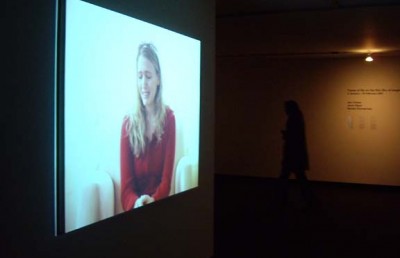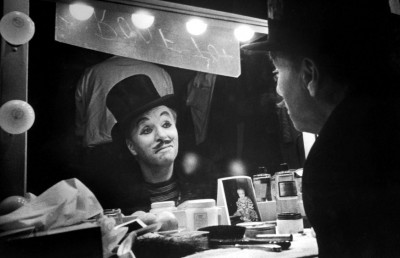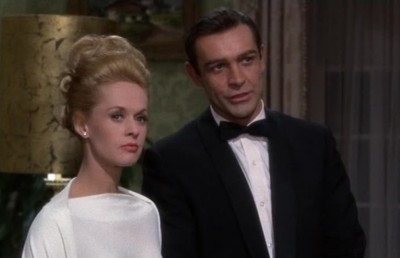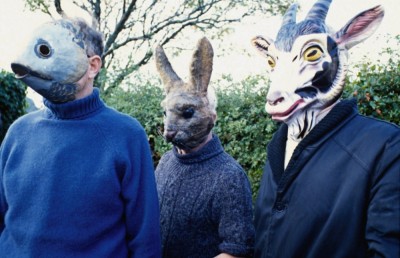Notes on Why We Make Movies and Dark Designs and Visual Culture
Daughters of the Dust, Eve’s Bayou, Nightjohn, and Sugar Cane Alley
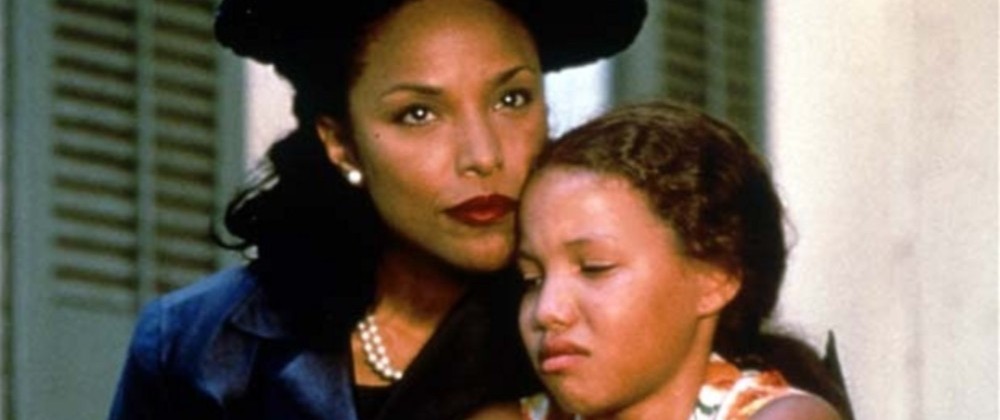
Why We Make Movies: Black Filmmakers Talk about the Magic of Cinema
By George Alexander
Harlem Moon/Broadway Books, New York, 2003
ISBN 0-7679-1181-4
528 pages
Dark Designs and Visual Culture
By Michele Wallace
Duke University Press, Durham, 2004
ISBN 0-8223-3427-5
511 pages
In films, I look for a representation or reinvention of the world; and pay attention to image, story, characters, action, dialogue, meaning, relevance, ending, and effect. Some of the films I like are: Chameleon Street, Confusion of Genders, The Constant Gardener, Dirty Pretty Things, Eve’s Bayou, Frances, Ganja and Hess, Get on the Bus, Hart’s War, Kinsey, Losing Ground, The Motorcycle Diaries, Oscar and Lucinda, The Others, Paradise Now, Sidewalk Stories, Stage Beauty, Strange Days, Sugar Cane Alley, The Talented Mr. Ripley, Three Kings, A Time for Drunken Horses, Time Regained, The Wind Will Carry Us, and Wonder Boys. In criticism, I look for an awareness of different cultures and different sources of knowledge; criticality informed by standards and possibilities; attention to details of both form and content; identification of contexts artistic, intellectual, historical, and social, especially the context and relevance of other art forms, such as literature and painting; cognizance of sources of energy—emotional, sensual, spiritual; and language use—articulation, comprehension, lyricism, wit. George Alexander is a lover of film, and his attention to detail is notable in his interviews in Why We Make Movies: Black Filmmakers Talk about the Magic of Cinema, and the book works as a contribution to film interpretation and knowledge. George Alexander’s questions and observations are so precise that he seems to have seen each director’s oeuvre the very morning of the day or night he spoke with the director. Alexander, a Morehouse College and Columbia University business school graduate, and contributor to Black Enterprise, Forbes, Savoy, and Variety, interviewed for his book Why We Make Movies some of the significant film directors who are African-American or of African descent—among them Charles Burnett, Euzhan Palcy, Julie Dash, and Kasi Lemmons (Gordon Parks, Melvin Van Peebles, and Spike Lee, and others, are interviewed). It seems strange to describe a book as friendly but this book is: and in the honest intelligence of the interviews, there is a sharing that inspires trust as well as provides illumination, as the interviews offer memories of and insight into particular films and the lives and careers of the people who made them as well as facts about the film industry and public film reception.
In Alexander’s book Why We Make Movies, actor and director Fred Williamson is funny when he describes his rules for his films—that he couldn’t be killed, that he wins all the fights, and that he gets the girl if he wants her (page 61); and funny when he describes his brash tactics (he’s funny partly because he is so serious) and also his legacy: “That I did whatever I wanted to do, whenever I wanted to do it, as many times as I wanted to do it” (70). Michael Schultz describes how he and his producers and collaborators made the movie Car Wash a musical for the discerning eye and ear (81-82). Kennen Ivory Wayan’s affirmation of business is important and realistic but his single-mindedness, which can seem very shallow, is also disappointing (147-150). Haile Gerima, the director of a reinvention of the slave narrative, Sankofa, hilariously describes the negrotic as something that is both loud and wrong—something that is against reason and sense, against context and history, something that affirms dependency and irresponsibility; and Gerima cites as negrotic wanting to dictate the décor in someone else’s property, such as occurs in Spike Lee’s Do the Right Thing (201-202). The interviews with St. Clair Bourne, Bill Duke, Carl Franklin, Warrington Hudlin and the other interviewees make George Alexander’s Why We Make Movies an entertaining and educational read. I have read the book two or three times, but my notes here are less a review than a recommendation. I love movies, and am curious and enthusiastic about the making and meaning of them; and the book made me feel less lonely.
It is a great thing to be able to read the thoughts of artists whose work you have admired, such as Charles Burnett, Euzhan Palcy, Julie Dash, and Kasi Lemmons. Mississippi native Charles Burnett studied at UCLA in the film department, and produced the well-revered films Killer of Sheep, To Sleep with Anger, The Glass Shield, and Nightjohn. As a student, Charles Burnett relished exploration of political cinema as well as exposure to directors such as Robert Bresson and Federico Fellini. Burnett says, “I remember Jean Renoir did a film called The Southerner, which I admired greatly as a kid. When I got to film school, they were talking about Europeans not being able to make movies about the South and used The Southerner as an example. I said, ‘They must be crazy,’ because I thought it was one of the best films because it didn’t take a typical plot or structure or American view of either romanticizing the victim, nor did it show white people coming to save the day. Renoir treated both a Black family and a white family equally. In one of the Renoir movies, either Rules of the Game or Grand Illusion, you see French Africans in bars with French troops having a good time singing and dancing with white women which is something you’d never see in American movies” (page 187). Burnett himself was eager to tell stories. Of Burnett’s own distinctive films, Killer of Sheep is about a demoralized Los Angeles slaughterhouse worker and his family; To Sleep with Anger about conflict and power in a family, conflicts that deepen when a provocative older male relative visits; The Glass Shield about an African-American who integrates a police office; and Nightjohn is about literacy in a time of slavery. It is mystifying to read in Alexander’s book, in Burnett’s interview, that To Sleep with Anger, which was welcomed by critics and the audiences that saw it, had been limited by the Samuel Goldwyn company to only eighteen theaters (no typo: after getting rave reviews from some of the most important critics in the country, only 18 theaters in all of the United States showed the film). I still recall, more than a decade later, Danny Glover’s sly performance as the troubling trickster, the visiting relative, in To Sleep with Anger. That is as fresh to me as the more recent Nightjohn, in which enslaved Africans are punished for learning to read and write by having their fingers chopped off.
Euzhan Palcy, born in Martinique, was a young short-story writer and an early appreciator of Alfred Hitchcock’s movies, as well as a youthful admirer of Truffaut and Costa-Gavras and Billy Wilder. Palcy was educated in Paris at the Sorbonne and the Louis Lumiere Film School, where she studied literature and film. Palcy made the great film Sugar Cane Alley. Euzhan Palcy recalled to George Alexander: “At the time, studying film was considered a luxury. Rich people paid to become filmmakers, because when you are from a country like Martinique you study to become a doctor, a professor or an engineer. That’s why there are so many lawyers, doctors, intellectuals and scientists in Martinique. They go back to work there. They study hard, and that was the story in Sugar Cane Alley. No one wants to go back to the sugarcane plantation because they’ve come from slavery and they know their grandparents paid the price for them. The grandmother in Sugar Cane Alley wanted the little boy to be somebody. She didn’t want him to have the same life she had. That’s every single parent in the Caribbean. You might be poor, but you have to be educated” (215-216). Palcy had read Joseph Fobel’s book Sugar Cane Alley (also known as Black Shack Alley) when Palcy was fourteen and she knew then that it should be a film. Truffaut, whom Palcy met through his daughter Laura while studying in Paris, was an early supporter of Palcy. Euzhan Palcy, an opera and theater lover, also made A Dry White Season and The Killing Yard, among other works. “Lighting is absolutely important, and there’s just so much you can do with light to express so many things and the sound is also important. But I was gifted because I was born in a country full of sound and color, so I had that in me when I opened my eyes as a baby,” Palcy says (217).
Julie Dash, the director of Daughters of the Dust and The Rosa Parks Story, is a New Yorker who studied film at the Studio Museum in Harlem and City College, before moving on to the American Film Institute and UCLA. That seems a great deal of positive direction for a high school student who once thought, “My mother and father were going to take care of me. I thought the revolution was going to take care of that. This was during the ‘70s” (234). Regarding Daughters of the Dust, Dash says, “We wanted to do an authentic African American film that was truly a foreign film to the eyes of Americans because it was so not like Hollywood in terms of the story structure” (237), also recalling the idiosyncratic—inventive, spiritual—choice to have two narrators, one an unborn child, and the other a great-grandmother. The film, about a family’s plan to leave its island home, and the family’s scars and hopes, is a film that is historical and imaginative, epic and intimate, earthy and lavish.
The director Kasi Lemmons was a distinctive actress—and I still recall her performance, with Jodie Foster, in Silence of the Lambs so many years later and her casts and crew have commended her for insights brought to directing from the field of acting. Missouri-born Kasi Lemmons’s Eve’s Bayou and The Caveman’s Valentine are two interesting and rewarding films: the first, set in 1960s Louisiana, with a doctor, his wife, and their children as the central characters, is about family, adultery, and the possibility of incest, while the second is about the meeting of different social strata when a dead male body, that of a model for a famous photographer, is found not far from where a homeless man sleeps in a park. Kasi Lemmons, whose mother studied clinical psychology at Harvard (with a focus on motivation in children), acted in children’s theater, but it was as an adult when Kasi Lemmons was acting but not getting enough work that Lemmons began to look at the other side of film and studied at the New School for Social Research. Lemmons wrote, and made documentaries, some of which were shown at festivals, and Lemmons was befriended by the filmmaking Hudlin brothers, Reggie and Warrington, and their foundation for black filmmakers. About Eve’s Bayou, after remarking on the glamour of her own parents and family and their friends, Lemmons says, “I wanted deep southern glamour because I just hadn’t seen it in a movie” (259). (Eve’s Bayou, also has, very attractively, a Native American presence, as does Daughters of the Dust.) Lemmons’s favorite authors include Toni Morrison and Gabriel Garcia Marquez, and she admires Hitchcock, Kurosawa, Polanski, Scorsese, and Truffaut. She was drawn to the central character in The Caveman’s Valentine: “I think the character of Romulus Ledbetter [played by Samuel L. Jackson] is a fantastic character. You just don’t see this character and I got really, really excited about it” (264). Romulus is a classical pianist who is disturbed and homeless and he becomes a detective when he follows the clues of what he begins to suspect is a murder. (I agree that Romulus is a fascinating character.) The reviews for Caveman’s Valentine were mixed, but I liked the film a lot.
The directors profiled—Charles Burnett, Euzhan Palcy, Julie Dash, Kasi Lemmons, and the rest—in George Alexander’s Why We Make Movies: Black Filmmakers Talk about the Magic of Cinema have lived and told very different stories: some received encouragement and support and became affiliated with important institutions, others got discouragement and learned in relative isolation by doing. Some produced work that received celebration and understanding, others received incomprehension or controversy. Their stories, of course, are very human stories: stories about desire and pleasure, thought and understanding, hope and effort, individuality and community; and they contribute to a wonderful book.
Human stories are not always recognized as such: they are sometimes seen as exemplars of the alien, of strangeness: and some people—such as African-Americans—have been made to embody the dangerous and the transgressive in American film, something artists such as Burnett, Palcy, Dash, and Lemmons contest with their rich works. “Images have histories and narratives of their own. The way not to be totally seduced is to keep that in mind,” said cultural critic Michele Wallace in a conversation with the Harvard Advocate that is published in Wallace’s anthology Dark Designs and Visual Culture (119). Michele Wallace comes with angers, confusions, and resentments, as well as intelligence, insight, and the most subtle nuances as she explores culture, theory, and politics, including film, literature, music, paintings, and photography, and feminism and postmodern thinking, as well as social life. Her book Dark Designs and Visual Culture, an anthology of her commentaries that spans more than two decades, strikes me as a fundamental, though flawed, work of our time, a work that if ignored bodes ill for many who want to contribute to public discourse about some of the most exciting art and demanding issues of our time. Michele Wallace as a very young woman first published a controversial criticism of sexism in the African-American community, a criticism that brought fame and is responsible for much of her conflict and pain, Black Macho and the Myth of the Superwoman: or more precisely, she recognized conflict and pain, wrote about that, and was chastised for what she wrote and the way she wrote, a chastisement that hurt her. Wallace, who also published Invisibility Blues: From Pop to Theory, has been writing against the censorious impulse in American and African-American cultures, whether that repression is rooted in conservatism, ignorance, racism, religiosity, or sexism. Her work subsequent to Black Macho has not only made up for whatever errors Black Macho contained, it has fulfilled her promise, though she can be immensely contradictory—such as criticizing and affirming unifying theories in a single conversation.
Images have histories; and much that we see in the broadest film and television comedies today, as well as much of the beat-centered, language propelling hip-hip music, seems a return to the buffoonish. (I think: Keenen Ivory Wayans satirized stereotypes in his early movies I’m Gonna Get You Sucka and Scary Movie??—but he seems increasingly, as in ??White Chicks and Little Man, to be pandering to them—to accepting cartoons as characters.) When reflecting on the images of blacks in America around the turn of the century—at the beginning of the twentieth century, with the popularity of black comedians and performers and the use of blackface paint in the minstrel tradition—Wallace remarked, “I’m interested in the fact that the genealogy of black stereotypes is closely shadowed by the genealogy of any type of authentic black culture. It gets more and more difficult after this period to tell one from the other” (121). Making distinctions here, and elsewhere, is what Wallace attempts—examining image and language, and thought and style, in context, and with rigor. “In the context of mass culture, the image of the black is larger than life. Historically, the body and the face of the black have posed no obstacle whatsoever to an unrelenting and generally contemptuous objectification. And yet, until recently, there has been no position within or outside American visual culture from which one could conceptualize the African American as subject. The prominence of black directors in film finally threatens to change that picture. But the difficulty of the project for black film has to do precisely with the history of a mostly invisible black visuality” (186).
To draw attention to the importance of visual art and popular culture, Wallace organized a black popular culture conference in the early 1990s—“For me, the purpose of this conference was to nurture critical practice among African American intellectuals. As an African American intellectual, I know how difficult it has been and continues to be to engage in critical cultural practices” (188). She feared that even there visual art would not be respected among thinkers who had learned to revere music and literature as the principal forms of communal expression—and she found instances when that disregard was so, and she was impressed by the integrity of the visual artists in attendance, their willingness to see and hear. In attendance were the artists Camille Billops, Mel Edwards, Renee Green, Seitu Jones, Lorraine O’Grady, and Wallace’s mother, the artist Faith Ringgold. “Black artists can be very quiet. I learned a new respect for the quiet ones; it is precisely the ones who are most quiet that we need to pay attention to,” she advises (191). (The same might be said of film artists: Charles Burnett, Euzhan Palcy, Julie Dash, and Kasi Lemmons are frequently the quiet ones.)
Structuralism often affirmed binary oppositions, a kind of dialectic, a push-and-pull and black-and-white way of seeing and describing the world, while poststructuralism—forms of thinking such as deconstruction and psychoanalysis—argued that categories cannot be defined absolutely, and certainly not by such simple oppositions: and thus, identity and meaning are not permanent or simple. In the early 1990s, Wallace had spoken of poststructuralism’s “failure to integrate postcolonial, minority, and multicultural perspectives and issues. As a white, male, academic discourse, it fails simply because it speaks in a major voice while the essence of these issues is minor” (240), but Wallace also wrote that postmodernism could become useful in looking at cultures high and low, made by persons of any gender or ethnicity (195-196). Wallace noted that the movies Boyz N the Hood by John Singleton and Jungle Fever by Spike Lee, two films that made a lot of noise on the public stage, showed the durability of certain questionable race and gender constructions (196). (For me, Charles Burnett, Euzhan Palcy, Julie Dash, and Kasi Lemmons produce works that frustrate stereotyping.) Michele Wallace stated, “As I understand it, postmodernism describes a development in late capitalism, technology, and communication. It permeates culture, even that portion of culture that says, ‘I deliberately set myself outside of you.’” (240). Wallace said, “The postmodernism I am interested in focuses on how peoples of color have been treated by these developments. The tools minority cultures work with are the same tools everyone else works with” (240).
Michele Wallace, who says filmmakers are responsible for fulfilling their own individual visions, describes being “completely swept away” by Boyz N the Hood until “a black single mother brought the demonization of black single mothers in the film to my attention” (215), and Wallace realized that “the success of such a movie at the box office reflects its power to confirm hegemonic family values” (216). Wallace went on to declare: “Spike Lee’s Jungle Fever, although a much more complicated film, worried me as well. In the context of representation, gender and race have no irreducible meanings, only the ones we assign them. But neither Singleton nor Lee seems aware of social constructions of race and gender” (216). Lee’s film treats interracial sex “much like a crime” (217), and “what this film is really about is the threat of a female or aberrant sexuality to traditional family values” (218). Wallace notes a married woman’s audible responsiveness during sex, a girl’s inquiry about sex, and a crack whore’s offer—and points out that bad things befall men who pursue women in the film. Michele Wallace acknowledges the perplexity of popular culture when she says “Boyz N the Hood and Jungle Fever demonize black female sexuality as a threat to black male heterosexual identity, and yet I find both films visually irresistible” (219).
Michele Wallace’s contradictions may be as important as her instances of unbroken logic, as those contradictions suggest the best of us cannot make our minds or ourselves simple. Wallace, like Bell Hooks, Stuart Hall, and Cornel West, reminds us of ideas and facts and work that we forget at our own peril (the common we, not the royal we—the vulnerable we). Wallace’s book Dark Designs and Visual Culture contains family photographs and attention to minute indications in contemporary thought, both personal and public matters, and her weakness may be the other side of her strength: that she is thoroughly informed by current cultural dialogues, and that she seems to leave little, if anything, without interrogation, without being subject to theory—free. I understand the impulse, and recall, many years ago, wanting to be aware of everything, wanting to occupy diverse positions—but there are tensions in that, not only enlightenment and pleasure but also stress and even pain. (There is more pleasure –and more intellectual freedom—in Why We Make Movies than Dark Designs and Visual Culture, not only because of the multiplicity of perspectives of the former but because, no matter the filmmakers’ social awareness, there are fewer ideological concerns and constraints: the depiction of humanity, and the practice of art, challenges ideology.) We cannot know everything nor be everyone or everywhere—though we can see, hear, and imagine. It is hard to know the right way to go—if there even is a right way. Which way is freedom? Ideally, I would not like my person to be turned into an anecdote, a statistic, a tool, denying and destroying the accidental, intended, and achieved complexity of my mind, experience, and work. Ideally, I would be described as intelligent, sensitive, creative, useful. Society teaches us to betray our individuality: that, I want to resist. Wallace, like most of us, capitulates and resists, capitulates and resists, all the while doing work that most of us do not do—and I think she has been a brave girl and a brave woman—and she has my respect and my sympathy.
Just as Daughters of the Dust can be compared to Eve’s Bayou for its beauty, sense of time, and respect for human mystery, it can be compared to the works of Robert Bresson, Claire Denis, Terrence Malick, and Alexander Sokurov for those same qualities—and, as Michele Wallace can be compared not only to Audre Lorde and Bell Hooks for her investigation of what it means to be a thinking woman, a philosophical, well-intentioned, and active human being, Wallace can be compared also to Adrienne Rich, Susan Sontag—and Michael Eric Dyson, Cornel West, Hal Foster, and Edward Said. I am not declaring equality, but rather identifying similar interests, similar landscapes, similar movements—an identifying both art and philosophy, and even forms of criticism, can do for us. However, I prefer art—making it and experiencing it—to reading about it: and so, relishing memory of certain faces and lines and scenes, I say again, some of the films I like are: Chameleon Street, Confusion of Genders, The Constant Gardener, Dirty Pretty Things, Eve’s Bayou, Frances, Ganja and Hess, Get on the Bus, Hart’s War, Kinsey, Losing Ground, The Motorcycle Diaries, Oscar and Lucinda, The Others, Paradise Now, Sidewalk Stories, Stage Beauty, Strange Days, Sugar Cane Alley, The Talented Mr. Ripley, Three Kings, A Time for Drunken Horses, Time Regained, The Wind Will Carry Us, and Wonder Boys. There is little like seeing the sun-blessed women in Daughters of the Dust and Eve’s Bayou walking in their beautiful dresses.


